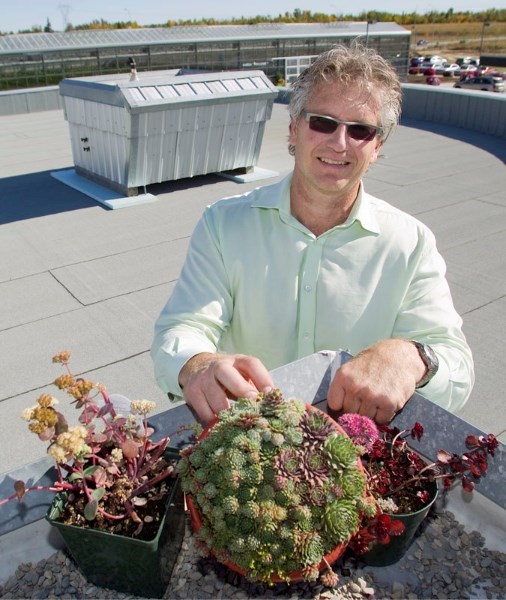Jim Hole says he can't stand to see a faucet left running.
"Drove Mom crazy, too," he adds, referring to Lois Hole.
So he's understandably pumped about the new water-saving rooftop gardens he's now testing at the Enjoy Centre in St. Albert. If these box-shaped devices work, they should help cool his greenhouse, slow the pace of rain runoff and save him money on roof repairs.
"If enough buildings do [these], that's a lot of water that's not all running off in one shot."
The Holes and the Northern Alberta Institute of Technology (NAIT) have teamed up to see how rooftop gardens can benefit Alberta buildings. Both will be at the Enjoy Centre this Saturday as part of the Plugged In and Officially Open event to promote water-saving technologies. The event celebrates the opening of all the centre's stores and will feature stilt-walkers, door prizes and a surprise the Gazette is forbidden to talk about.
Water has always been a big issue for the Holes, says Hole, co-owner of the Enjoy Centre, which is why they've made it the theme of this weekend's event.
"Water is a precious resource and we can't squander it."
What's with those boxes?
NAIT installed four rooftop gardens on top of the Enjoy Centre back in August to promote green roofs, explains project co-ordinator Dave Critchley. Essentially big silver boxes topped with gravel, they look a bit like HVAC-units.
NAIT students will fill these gardens with plants and dirt next spring to figure out which ones work best in Alberta's climate, Critchley says. They'll also use a battery of sensors to track the modules' effects on the Enjoy Centre's temperature and stormwater flows.
Fly over a city like Calgary, Hole notes, and you'll see how almost all the roofs of the commercial buildings are flat and black.
Recent research suggests this is a dumb idea. Black roofs absorb more heat, which raises cooling bills in the summer, and do nothing to stop water from rushing into sewers during storms, which can cause flooding. They also suffer from big temperature swings, Critchley notes, causing expansion and contraction and greater wear and tear.
Modern roofs also take big chunks of farmland out of production, Hole notes. "There has to be a better way to deal with that roof space."
One alternative is a green roof. Popular in Europe, Critchley explains, green roofs replace tar-paper with plants that look pretty, absorb water, boost insulation and cool through evapotranspiration.
A 2005 study by the National Research Council of Canada found that temperatures on a green roof fluctuated about 6 C a day, compared to 45 C for a regular roof. While the normal roof often roasted at 70 C, the green roof chilled out at 25, creating an almost 75-per-cent drop in the building's cooling needs.
Green roofs should cool buildings and reduce wear from thermal expansion, says Critchley, saving building owners money.
"We're looking at potentially doubling or more the lifespan of a traditional rooftop."
Toronto already has many rooftop gardens, Hole notes, and he hopes to have a vegetable garden on top of the Enjoy Centre next year.
"This [experiment] will be something that will help everyone down the road."
Aquaculture on tap
Visitors to the centre will be able to talk to NAIT students about the rooftop gardens and learn about other water saving measures like the building's rainwater system.
Alberta Agriculture scientist Nick Savidov will also be there to talk about the aquaponics project the centre will host next year. Unlike hydroponics, which puts plants in water loaded with artificial fertilizer, aquaponics have plants grow on top of fish tanks. Those tanks are full of fish and bacteria, the latter of which convert the fish poop into plant food.
"It's like a mini wetland system," Hole says, and lets you grow plants and fish in the same spot with the same water. "It's the most efficient use of water you can find."
The Plugged In event runs from 10 a.m. to 4 p.m. this Oct. 1. Call 780-419-6800 for details.




